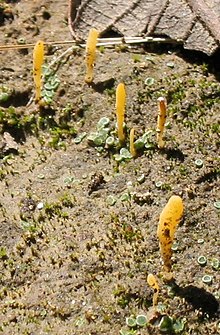
Basidiolichens are lichenized members of the division Basidiomycota within the subkingdom Dikarya of the kingdom Fungi. They form a diverse yet much smaller group of lichens than the far more common ascolichens of the division Ascomycota. Owing to how few described species there are, basidiolichens are generally considered to be poorly researched, and few studies that characterize their natural products exist. Biogeographically, basidiolichen species may be distributed in a cosmopolitan manner or more regionally, ranging from arctic and montane habitats to more temperate and tropical environments. Morphologically, basidiocarp and thallus structures may vary widely within and between basidiolichen genera.

Enterographa is a genus of lichens in the family Roccellaceae.

Lecanactis is a genus of crustose lichens, commonly called old wood rimmed lichen. The genus was circumscribed in 1855 by German lichenologist Gustav Wilhelm Körber, who assigned Lecanactis abietina as the type species.

Syncesia is a genus of lichen-forming fungi in the family Roccellaceae.

Nyungwea is a genus of lichen-forming fungi in the family Opegraphaceae. It was circumscribed in 2006 by Emmanuël Sérusiaux, Eberhard Fischer, and Dorothee Killmann, with Nyungwea pallida assigned as the type species.

Multiclavula is a genus of basidiolichens in the family Hydnaceae. The widespread genus contains 14 species. The genus was circumscribed by the American mycologist Ron Petersen in 1967, with Multiclavula corynoides assigned as the type species.

Lepidostromatales is an order of fungi in the class Agaricomycetes. It is the only known order of basidiomycete fungi composed entirely of lichenized members. Morphologically, the fruiting bodies of all species are clavarioid. Six species are known, five of which were described within the span of 2007–2013. Due to its morphological similarity to the genus Multiclavula, its isolated phylogenetic position was not understood until quite recently. The photobionts that have been found in association with members of this group are not known to associate with any other types of lichenized fungi.
Ertzia is a monospecific genus in the family Lepidostromataceae. The sole species is Ertzia akagerae, a basidiolichen. The genus was circumscribed in 2014 by Brendan Hodkinson and Robert Lücking. Ertzia is distinguished from all other lichenized clavarioid fungi by having a microsquamulose thallus that forms contiguous glomerules with a cortex of jigsaw puzzle-shaped cells. Ertzia akagerae grows on soil in the African tropics.
Sulzbacheromyces is a genus of basidiolichens in the family Lepidostromataceae. The genus is distinguished from the other genera of Lepidostromataceae by having an entirely crustose thallus and from Multiclavula (Cantharellales) by having a chlorococcoid photobiont. The type species grows on soil in the neotropics.

Malmideaceae is a family of crustose and corticolous lichens in the order Lecanorales. It contains eight genera and about 70 species.

Cora is a large genus of basidiolichens in the family Hygrophoraceae. Modern molecular phylogenetics research has revealed a rich biodiversity in this largely tropical genus.

Opegraphaceae is a family of lichen-forming and lichenicolous fungi in the order Arthoniales. It was originally proposed by German lichenologist Ernst Stizenberger in 1862. It fell into disuse, but was resurrected in a molecular phylogenetic study of the order Arthoniales published in 2010. It now includes taxa that were previously referred to the family Roccellaceae, its sister group.
James Donald Lawrey is a biologist, specializing in lichens. He is known for leading long-term monitoring projects, taxonomy and studies of the evolution of the fungi in lichens.
Sulzbacheromyces fossicola is a species of basidiolichen in the family Lepidostromataceae. First described in 1950 by E. J. H. Corner as Clavaria fossicola, it is characterised by its dark green to indigo blue crusty growth form and distinctive white, club-shaped fruiting bodies that turn beige when dried. The species forms a thin layer on soil or rocks, where it lives in symbiosis with microscopic green algae. It is distributed across tropical and subtropical Asia, from India to Singapore, where it specifically grows on exposed yellow and red clay soils in shaded locations. The species was transferred to Sulzbacheromyces in 2017 based on molecular and morphological evidence.
Sulzbacheromyces miomboensis is a species of basidiolichen in the family Lepidostromataceae. Found in the Democratic Republic of the Congo, as was described as new to science in 2017.
Sulzbacheromyces sinensis is a species of basidiolichen in the family Lepidostromataceae. It is found in Asia.
Sulzbacheromyces tutunendo is a species of basidiolichen in the family Lepidostromataceae. It is found in Colombia.
Sulzbacheromyces chocoensis is a species of soil-dwelling basidiolichen in the family Lepidostromataceae. It forms a thin, olive-green crust on clay soil and produces distinctive unbranched, reddish-orange to yellowish reproductive structures. The species was described in 2018 from specimens collected in Colombia's Chocó Biogeographic Region, where it grows in tropical rainforest environments.
Sulzbacheromyces caatingae is a species of basidiolichen in the family Lepidostromataceae. Discovered in 2012 in northeastern Brazil, it is characterised by its thin green crustose thallus and distinctive orange-pink, club-shaped reproductive structures. The species has a broad ecological amplitude, occurring across different vegetation types from the semi-arid Caatinga to humid Atlantic Forest fragments, where it grows on soil banks and termite nests near forest edges. As the type species of the genus Sulzbacheromyces, it represents a unique evolutionary lineage within the order Lepidostromatales and can be distinguished from similar-looking species by its undifferentiated thallus structure and association with green algae.

Lepidostroma vilgalysii is a species of basidiolichen in the family Lepidostromataceae. Discovered in 2012 in Mexico's Trans-Mexican Volcanic Belt, it grows in small green patches on clay banks in high-altitude pine forests. The species is distinctive because of its unusual "window lichen" structure, where its algal partner is concentrated in a layer at the base rather than near the surface as in most lichens. Its most distinctive features are its club-shaped reproductive structures, which are pale yellow to orange-brown with cream-colored tips, and its scale-like body parts that have white, raised edges. It is known only from a single location near San José Teacalco, Tlaxcala, at an elevation of about 3,000 m (9,800 ft) above sea level.









